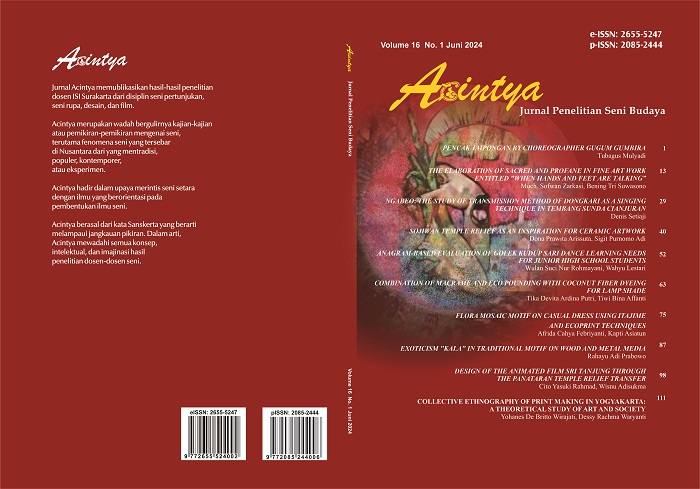COMBINATION OF MACRAME AND ECO POUNDING WITH COCONUT FIBER DYEING FOR LAMP SHADE
DOI:
https://doi.org/10.33153/acy.v16i1.5400Keywords:
Coconut Fiber, Macrame, Eco pounding , LampshadeAbstract
This design is motivated by the use of coconut fiber, which in general the community uses it as fuel and is considered a disturbing waste and causes buildup as coconut production increases. Technological developments and public awareness to return to natural materials will make coconut coir used as a natural dye for fibers (cloth or rope). The use of natural coconut fiber dyes is not widely known even though it has considerable potential to be developed and has a high selling value.
The design method used in this design uses the theory of S.P Gustami which consists of 3 stages: namely exploration, design, and embodiment of the work. The exploration stage includes extracting sources of ideas about macrame, eco pounding, lamps and coconut coir. The design stage includes the selection of materials, techniques, and the visual form of the work. The final stage is the embodiment of the work.
The final result of this design is in the form of six alternative designs, one of which was chosen to be realized. The realization of the work is in the form of a decorative lampshade on the table which has a function not only as lighting, but also as a decorative element and can beautify a room. This lampshade is presented by applying a combination of macrame and eco pounding techniques which are the novelty of this product. The use of natural coconut coir dyes is one way to preserve the environment.
Downloads
References
Azzaki, Dawud Abdullah., et al. 2020. “Potensi Pemanfaatan Limbah Serabut Kelapa (Cocofiber) menjadi Pot Serabut Kelapa (Cocopot)” Jurnal Teknologi Lingkungan Lahan Basah. Vol. 8 No. 1, 2020, Hal. 39-48
Budiyono, dkk. 2008. Kriya Tekstil Jilid 3. Jakarta: Direktorat Pembinaan Sekolah Menengah Kejuruan, Direktorat Jenderal Manajemen Pendidikan Dasar dan Menengah Departemen Pendidikan Nasional
Fatikawati, Ulfi. 2022. Totebag ecoprint daun Jati sebagai Representasi Kampanye Ramah Lingkungan. Tugas Akhir, Institut Seni Indonesia Yogyakarta
Fitriyah, H., & Ciptandi, F. (2018). Pengolahan Limbah Sabut Kelapa Tua Sebagai Pewarna Alam Pada Produk Fesyen. eProceedings of Art & Design, 5(3).
Gustami SP., (2007). Butir-Butir Mutiara Estetika Timur: Ide Dasar Penciptaan Seni Kriya. Indonesia., Yogyakarta: Prasista.
Husna, Farisah. 2016. “Eksplorasi Teknik Eco Dyeing dengan Tanaman sebagai Pewarna Alam”. Proceeding of Art & Design, 2, III,
Kurniati., Karnia, Urmila., dan Haerani. 2021. “Pemanfaatan Sabut Kelapa Sebagai Pewarna Alami dengan Teknik Jumputan Menggunakan Fiksator Kapur Tohor pada Kain Katun” Jurnal HomeEc. Vol. 16 No 1, April 2021, Hal. 37-40
Mariana, Novita., et al. 2021. “Pemanfaatan Sabut Kelapa Sebagai Pewarna Alami Batik Bagi Masyarakat Kelurahan Sembungharjo Kecamatan Genuk Kota Semarang”. Vol. 2 No 1, 2021, Hal. 48-52
Yustana, P., 2023. WUWUNGAN SEBAGAI SUMBER IDE PENCIPTAAN LAMPU DUDUK KERAMIK. Acintya, 15(2), pp.193-212.
Prabowo, R.A. and Marwati, S., 2019. Visualisasi Tiga Dimensional Motif Batik Pada Media Kayu. Acintya, 12(1), pp. 1-16.
Afrizal, A. and Prabowo, R.A., 2022. PENERAPAN MOTIF UKIR TRADISI PADA BLOK MESIN SEPEDA MOTOR. Acintya, 14(1), pp.1-16.
Downloads
Published
How to Cite
Issue
Section
License
Copyright (c) 2024 Tika Devita Ardina Putri

This work is licensed under a Creative Commons Attribution 4.0 International License.
Author continues to retain the copyright if the article is published in this journal. The publisher will only need publishing rights




